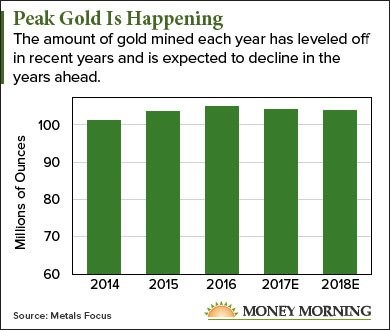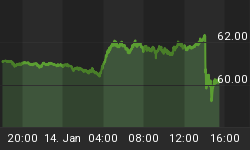For more than five millennia, gold has been one of the world's most valuable metals, with man's insatiable appetite for it timeless and universal—even religious.
One reason gold is so valuable is because it's such a finite resource and so rare. In fact, gold is so rare that its abundance in the earth's crust is a mere 0.00000031 percent; by comparison, copper's is 0.0068 percent, or about 2,199 times more abundant than gold, while iron is two million times more abundant.
Yet, rare is a relative term here.
The planet is so large that there's an estimated 122 billion metric tons of gold buried in the earth's crust and in the seas. For perspective, all the gold that has ever been mined in history is a mere 200,000 metric tons. That's compact enough to fit in just a single Olympic-sized swimming pool.
Looks like we have not even scratched the surface when it comes to pulling the yellow metal from the ground. So, what's all the talk by gold bugs about “peak gold”?
Are We Really Nearing Peak Gold?
The irony of gold is that our modern technologies have not been able to improve much on supply. In fact, most gold-mining technologies were developed in the 18th century with much of the gold in use today deriving from that period.
You see, peak gold is all about how much gold is reasonably and economically recoverable. Peak gold refers to the point where gold production reaches a zenith and then starts tailspinning, with production declining faster than ever.
Peak gold represents a great watershed for the precious metal. Unfortunately (or fortunately for gold bugs), that could be happening as we speak.
Since 2015, gold production has been flattening and peak gold appears to have been reached in 2016. Meanwhile, discovery of mineable gold peaked much earlier--in 1995, when 140 million ounces were discovered. Since then, success in finding new reserves has plummeted markedly with just 10 million ounces discovered in 2013.

Source: Money Morning
The Immutable Law of Supply and Demand
There's no consensus on whether we have truly reached peak gold or not. After all, we’ve been hearing the same thing said about oil since the 1950s, before hydraulic fracturing--an ingenious technology whereby chemical-laced water is injected into subterranean rock formations to break them up. That released millions of barrels of previously unreachable deposits and left the world awash in the commodity. Related: The Cyber Heists Banks Don't Want You To Know About
Gold production has also been happening in boom-and-bust cycles. During the last century, there were three periods when gold production declined by as much as 30 percent before taking off again.
Global gold production reached an all-time high at the turn of the millennium, with critics of peak gold theory saying the subsequent decline was caused by the commodity bear market of the 80s and 90s.

(Click to enlarge)
Source: WealthDaily.com
What we cannot escape, however, is the inexorable law of supply and demand.
The moment gold demand starts to outstrip supply by a considerable margin, gold prices will shoot up.
About 50 percent of gold supply goes into jewelry, while central banks take up another 35 percent. Most central banks across the globe have lately been building up their reserves. It probably won't take more than a few years before supply stress starts accumulating in the market, leading to higher prices--if we have truly hit peak gold.
By Alex Kimani for Safehaven.com
More Top Reads From Safehaven.com
















